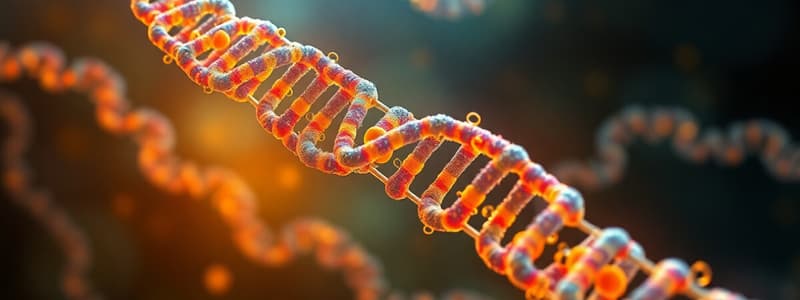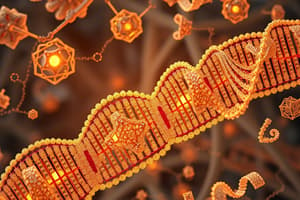Podcast
Questions and Answers
What is the primary purpose of adding a 7 methyl guanosine cap to the 5' end of mRNA?
What is the primary purpose of adding a 7 methyl guanosine cap to the 5' end of mRNA?
- To provide a binding site for ribosomes
- To protect mRNA from degradation (correct)
- To serve as a signal for splicing
- To facilitate the addition of the poly-adenylate tail
Which component is essential for the splicing of introns from the primary mRNA transcript?
Which component is essential for the splicing of introns from the primary mRNA transcript?
- Ribosome
- Polymerase enzyme
- Transcription factors
- Spliceosome (correct)
What characteristic do introns have in relation to primary transcripts?
What characteristic do introns have in relation to primary transcripts?
- They are coding regions
- They are noncoding regions (correct)
- They are removed by ribosomes
- They facilitate translation
What is the role of the poly-adenylate tail added to the 3' end of mRNA?
What is the role of the poly-adenylate tail added to the 3' end of mRNA?
In which cellular compartment does the processing of mRNA primarily occur?
In which cellular compartment does the processing of mRNA primarily occur?
Which of the following statements about primary transcripts is correct?
Which of the following statements about primary transcripts is correct?
What is a characteristic of the splicing process of mRNA?
What is a characteristic of the splicing process of mRNA?
How does the addition of a poly-adenylate tail affect the stability of mRNA?
How does the addition of a poly-adenylate tail affect the stability of mRNA?
What is the primary function of capping in mRNA processing?
What is the primary function of capping in mRNA processing?
Which statement best describes the role of the spliceosome in mRNA processing?
Which statement best describes the role of the spliceosome in mRNA processing?
What is the approximate range of adenine nucleotides added during the polyadenylation of mRNA?
What is the approximate range of adenine nucleotides added during the polyadenylation of mRNA?
What happens to the introns during the splicing process?
What happens to the introns during the splicing process?
What is the significance of processing the primary transcript of tRNA?
What is the significance of processing the primary transcript of tRNA?
How is energy implicated in the splicing process of mRNA?
How is energy implicated in the splicing process of mRNA?
What defines the primary transcript in relation to mature mRNA?
What defines the primary transcript in relation to mature mRNA?
What is the role of the 3' poly-adenylate tail in mRNA?
What is the role of the 3' poly-adenylate tail in mRNA?
What processes must the primary transcript undergo to become mature mRNA?
What processes must the primary transcript undergo to become mature mRNA?
Explain the role of the spliceosome in mRNA processing.
Explain the role of the spliceosome in mRNA processing.
How does the addition of the 7 methyl guanosine cap benefit the mRNA molecule?
How does the addition of the 7 methyl guanosine cap benefit the mRNA molecule?
Why is the splicing of introns considered an energy-requiring process?
Why is the splicing of introns considered an energy-requiring process?
What is the significance of adding a poly-adenylate tail to the 3' end of the mRNA?
What is the significance of adding a poly-adenylate tail to the 3' end of the mRNA?
Describe the sequence alterations that occur during tRNA maturation.
Describe the sequence alterations that occur during tRNA maturation.
What are introns, and how are they handled during mRNA processing?
What are introns, and how are they handled during mRNA processing?
How does the processing of primary transcripts affect their subsequent function in the cell?
How does the processing of primary transcripts affect their subsequent function in the cell?
What is meant by the term 'primary transcript' in the context of mRNA?
What is meant by the term 'primary transcript' in the context of mRNA?
Why is the addition of a poly-adenylate tail important for mRNA stability?
Why is the addition of a poly-adenylate tail important for mRNA stability?
What role does the splicing process play in mRNA maturation?
What role does the splicing process play in mRNA maturation?
How does capping at the 5' end of mRNA contribute to its function?
How does capping at the 5' end of mRNA contribute to its function?
What is the significance of the spliceosome in mRNA processing?
What is the significance of the spliceosome in mRNA processing?
How do primary transcripts differ in their structure from mature mRNA?
How do primary transcripts differ in their structure from mature mRNA?
What modifications occur at the 3' end of mRNA during processing?
What modifications occur at the 3' end of mRNA during processing?
What are the key processing steps that a primary transcript must undergo to become mature mRNA?
What are the key processing steps that a primary transcript must undergo to become mature mRNA?
Flashcards are hidden until you start studying
Study Notes
Post Transcriptional Modification
- Most eukaryotic RNA transcripts (mRNA, rRNA, and tRNA) undergo processing after transcription.
- The primary transcript is the mRNA formed and released from the DNA template.
- This primary transcript undergoes extensive processing to become mature mRNA.
- Processing mainly occurs within the nucleus.
mRNA Processing
- Three main types of mRNA processing:
- Capping: Addition of a 7-methyl guanosine cap to the 5' end of mRNA
- Protects the 5' end from exonucleases.
- Facilitates translation initiation.
- Tailing: Addition of a poly-adenylate tail (20-250 adenine nucleotides) to the 3' end of mRNA
- Protects the 3' end from exonucleases.
- Facilitates translation.
- Splicing: Removal of introns and joining exons together
- Primary transcripts are long and contain both coding (exons) and non-coding regions (introns).
- Splicing removes introns and joins exons to create a mature mRNA molecule.
- Capping: Addition of a 7-methyl guanosine cap to the 5' end of mRNA
Spliceosome
- Spliceosome is the molecular complex responsible for splicing.
- Splicing is an energy-requiring process.
tRNA Processing
- tRNA is also processed from a large precursor molecule.
- The processing involves:
- Removal of sequences at both ends of the precursor molecule.
- Other modifications to the tRNA molecule.
Post-Transcriptional Modification
- Eukaryotic RNA transcripts undergo extensive processing before they can function.
- Primary transcripts of mRNA, rRNA, and tRNA are modified.
- mRNA processing occurs mainly in the nucleus.
- mRNA processing includes capping, tailing, and splicing.
Capping
- A 7-methyl guanosine cap is added to the 5' end of mRNA.
- The cap is added by mRNA polymerase.
- The cap protects the 5' end from exonucleases.
- The cap is required for efficient translation initiation.
Tailing
- A poly-adenylate (poly-A) tail is added to the 3' end of mRNA.
- The tail consists of 20-250 adenine nucleotides.
- The tail protects the 3' end from exonucleases.
- The tail facilitates translation.
Splicing
- Introns are removed from the primary transcript and exons are joined together.
- The spliceosome is a molecular complex that performs splicing.
- Splicing requires energy.
- The primary transcript is very long and contains coding regions (exons) interrupted by noncoding regions (introns).
tRNA Processing
- tRNA is made from a large precursor molecule that undergoes modifications.
- Sequences at both ends of the tRNA precursor molecule are removed.
Post Transcriptional Modification in Eukaryotic RNA
- Nearly all eukaryotic RNA, including messenger RNA (mRNA), ribosomal RNA (rRNA), and transfer RNA (tRNA), undergoes significant processing between synthesis and function.
- Primary transcript mRNA is formed and released from the DNA template and requires extensive processing to become mature mRNA.
- Processing primarily occurs within the nucleus.
mRNA Processing
- Capping: Addition of a 7-methyl guanosine cap to the 5' end of mRNA.
- Protects the 5' end from attack by 5' to 3' exonucleases.
- Required for efficient translation initiation.
- Tailing (polyadenylation): Addition of a poly-adenylate tail (20-250 adenine nucleotides) to the 3' end of mRNA by poly-A polymerase.
- Protects the 3' end from attack by 3' to 5' exonucleases.
- Facilitates translation.
- Splicing: Removal of non-coding regions (introns) and joining the ends of neighboring coding regions (exons).
- The primary transcript is very long and contains both coding (exons) and non-coding (introns) regions.
- Performed by a molecular complex called a spliceosome.
- Splicing requires energy.
tRNA Processing
- tRNA is made from a large precursor molecule that requires modification.
- Sequences at both ends of the precursor molecule are removed.
Post-Transcriptional Modifications
-
Nearly all eukaryotic RNA primary transcripts undergo extensive processing following synthesis.
-
Primary transcripts of mRNA, rRNA, and tRNA are processed to become functional RNA.
-
Processing occurs primarily in the nucleus.
mRNA Processing
-
Capping: Addition of a 7-methyl guanosine cap to the 5' end of the mRNA by mRNA polymerase.
- Protects the 5' end from attack by 5' to 3' exonucleases.
- Required for efficient translation initiation.
-
Tailing: Addition of a poly-adenylate tail (20-250 adenine nucleotides) to the 3' end of the mRNA.
- Protects the 3' end from attack by 3' to 5' exonucleases.
- Facilitates translation.
-
Splicing: Removal of introns and joining the ends of neighboring exons.
- Primary transcripts are long and contain coding regions (exons) interrupted by noncoding regions (introns).
- The spliceosome performs the splicing process, which requires energy.
tRNA Processing
- tRNA is generated from a large precursor molecule.
- Sequences at both ends of the precursor are removed.
Studying That Suits You
Use AI to generate personalized quizzes and flashcards to suit your learning preferences.




